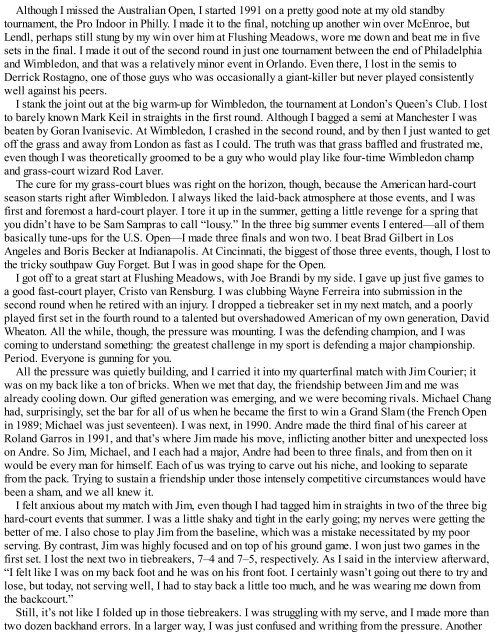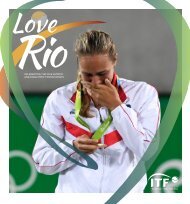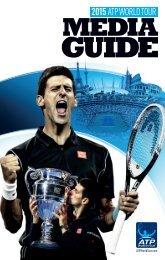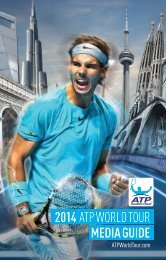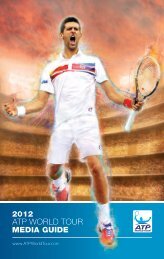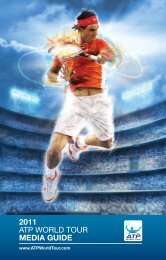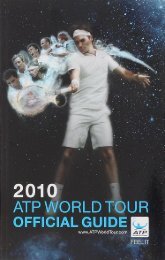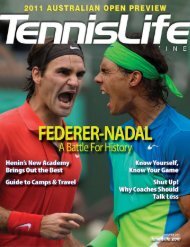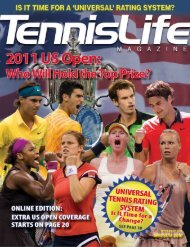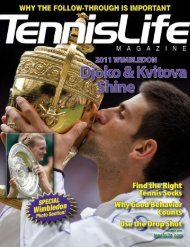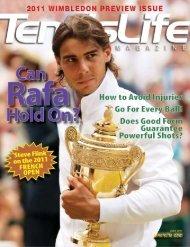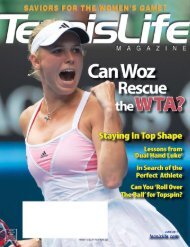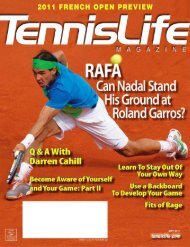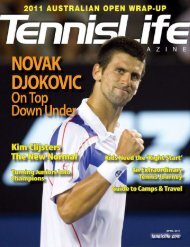A Champion's Mind - Pete Sampras
www.tennismoscow.me Insta:TENNISMOSCOW
www.tennismoscow.me Insta:TENNISMOSCOW
You also want an ePaper? Increase the reach of your titles
YUMPU automatically turns print PDFs into web optimized ePapers that Google loves.
Although I missed the Australian Open, I started 1991 on a pretty good note at my old standby<br />
tournament, the Pro Indoor in Philly. I made it to the final, notching up another win over McEnroe, but<br />
Lendl, perhaps still stung by my win over him at Flushing Meadows, wore me down and beat me in five<br />
sets in the final. I made it out of the second round in just one tournament between the end of Philadelphia<br />
and Wimbledon, and that was a relatively minor event in Orlando. Even there, I lost in the semis to<br />
Derrick Rostagno, one of those guys who was occasionally a giant-killer but never played consistently<br />
well against his peers.<br />
I stank the joint out at the big warm-up for Wimbledon, the tournament at London’s Queen’s Club. I lost<br />
to barely known Mark Keil in straights in the first round. Although I bagged a semi at Manchester I was<br />
beaten by Goran Ivanisevic. At Wimbledon, I crashed in the second round, and by then I just wanted to get<br />
off the grass and away from London as fast as I could. The truth was that grass baffled and frustrated me,<br />
even though I was theoretically groomed to be a guy who would play like four-time Wimbledon champ<br />
and grass-court wizard Rod Laver.<br />
The cure for my grass-court blues was right on the horizon, though, because the American hard-court<br />
season starts right after Wimbledon. I always liked the laid-back atmosphere at those events, and I was<br />
first and foremost a hard-court player. I tore it up in the summer, getting a little revenge for a spring that<br />
you didn’t have to be Sam <strong>Sampras</strong> to call “lousy.” In the three big summer events I entered—all of them<br />
basically tune-ups for the U.S. Open—I made three finals and won two. I beat Brad Gilbert in Los<br />
Angeles and Boris Becker at Indianapolis. At Cincinnati, the biggest of those three events, though, I lost to<br />
the tricky southpaw Guy Forget. But I was in good shape for the Open.<br />
I got off to a great start at Flushing Meadows, with Joe Brandi by my side. I gave up just five games to<br />
a good fast-court player, Cristo van Rensburg. I was clubbing Wayne Ferreira into submission in the<br />
second round when he retired with an injury. I dropped a tiebreaker set in my next match, and a poorly<br />
played first set in the fourth round to a talented but overshadowed American of my own generation, David<br />
Wheaton. All the while, though, the pressure was mounting. I was the defending champion, and I was<br />
coming to understand something: the greatest challenge in my sport is defending a major championship.<br />
Period. Everyone is gunning for you.<br />
All the pressure was quietly building, and I carried it into my quarterfinal match with Jim Courier; it<br />
was on my back like a ton of bricks. When we met that day, the friendship between Jim and me was<br />
already cooling down. Our gifted generation was emerging, and we were becoming rivals. Michael Chang<br />
had, surprisingly, set the bar for all of us when he became the first to win a Grand Slam (the French Open<br />
in 1989; Michael was just seventeen). I was next, in 1990. Andre made the third final of his career at<br />
Roland Garros in 1991, and that’s where Jim made his move, inflicting another bitter and unexpected loss<br />
on Andre. So Jim, Michael, and I each had a major, Andre had been to three finals, and from then on it<br />
would be every man for himself. Each of us was trying to carve out his niche, and looking to separate<br />
from the pack. Trying to sustain a friendship under those intensely competitive circumstances would have<br />
been a sham, and we all knew it.<br />
I felt anxious about my match with Jim, even though I had tagged him in straights in two of the three big<br />
hard-court events that summer. I was a little shaky and tight in the early going; my nerves were getting the<br />
better of me. I also chose to play Jim from the baseline, which was a mistake necessitated by my poor<br />
serving. By contrast, Jim was highly focused and on top of his ground game. I won just two games in the<br />
first set. I lost the next two in tiebreakers, 7–4 and 7–5, respectively. As I said in the interview afterward,<br />
“I felt like I was on my back foot and he was on his front foot. I certainly wasn’t going out there to try and<br />
lose, but today, not serving well, I had to stay back a little too much, and he was wearing me down from<br />
the backcourt.”<br />
Still, it’s not like I folded up in those tiebreakers. I was struggling with my serve, and I made more than<br />
two dozen backhand errors. In a larger way, I was just confused and writhing from the pressure. Another


